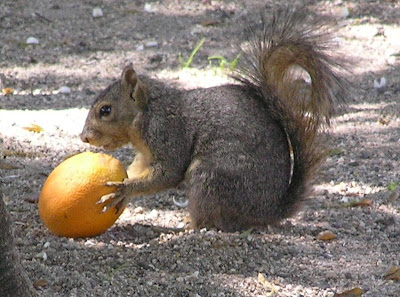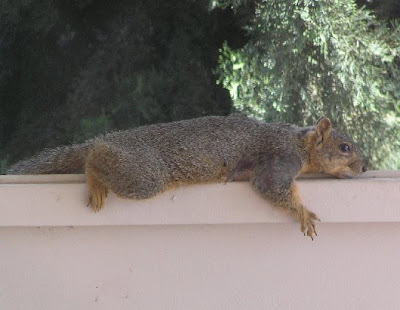
This little guy is a member of the species sciurus niger, commonly known as the fox squirrel. These active rodents are seen all over the valley in back yards and parks, running along telephone wires, scampering across roofs, getting run over in the streets, and picking fruit from the trees just as it is about to ripen. Maddeningly, they usually eat just a few bites and discard the rest.
 The fox squirrel is not native to California. Around 1904, military veterans from the Mississippi Valley area, who were staying at the Sawtelle Veterans Home on Wilshire Boulevard in Los Angeles, brought the animals here from their homes. By the 1940s the fox squirrel had come to be considered an agricultural pest. During the past century, it has expanded its range, and is now found throughout the Santa Monica Mountains, San Fernando Valley and Simi Valley. The animals are seen as far south as the Palos Verdes Peninsula, and to the east throughout Orange County. After so many generations, they probably consider themselves natives, but many naturalists are concerned that they may be displacing our true native species, the western gray squirrel (sciurus griseus).
The fox squirrel is not native to California. Around 1904, military veterans from the Mississippi Valley area, who were staying at the Sawtelle Veterans Home on Wilshire Boulevard in Los Angeles, brought the animals here from their homes. By the 1940s the fox squirrel had come to be considered an agricultural pest. During the past century, it has expanded its range, and is now found throughout the Santa Monica Mountains, San Fernando Valley and Simi Valley. The animals are seen as far south as the Palos Verdes Peninsula, and to the east throughout Orange County. After so many generations, they probably consider themselves natives, but many naturalists are concerned that they may be displacing our true native species, the western gray squirrel (sciurus griseus).



